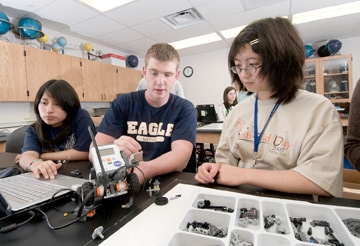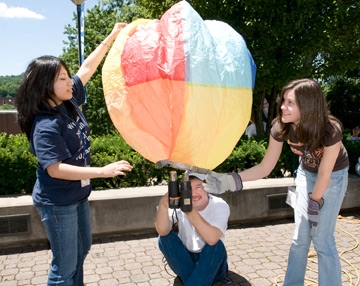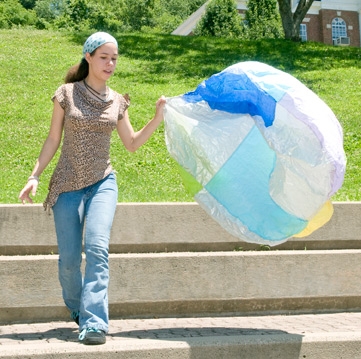
West Virginia high school students are shown during
the robotics component of Glenville State College's NASA
Research Academy. (L-R) Elizabeth Quispe, a student at
Mussleman High School; Kalob Miller, who attends Hedgesville
High School, and Susan Chang, a student at Hampshire High School.
Story and Photos by Drew Moody
High school students from across West Virginia are getting hands-on lab and field experience utilizing equipment most of their peers won't see until college.
Glenville State College's NASA grant has funded the purchase of more than $1-Million in modern equipment often out-of-reach for a small college.
Teaching techniques familiar to students a generation ago virtually no longer exist.
In this environment, the instructor is mentor, facilitator and guide while acting as a partner with students in the learning process.
Teamwork is encouraged. Critical thinking and problem solving skills are actively practiced - not part of a multiple choice option in a vocabulary test.
In short; learning is more enjoyable.
NASA Research Academies
Twenty-eight high school students arrived June 15.
Areas of study include robotics, rocketry and flight, electronics, radio astronomy, web page development, fuels, and spectroscopy.
In one class students begin by learning simple commands to move a robot. The next level is understanding how the robot interacts with color, light, sound, distance and touch.
Ultimately the robots are programmed for specific tasks. Onboard sensors gather the required information permitting it to discriminate between objects in the environment to navigate or retrieve objects.

Elizabeth Quispe and Jamie Hand, a Pendleton County
High School student, stabilize their hot air balloon
as GSC faculty member Larry Baker fills it with air.

Rebecca Britton, a student at Huntington High School, retrieves a high-flying hot air balloon. She and Stephen McCartney, a student at Webster County High School pieced the tissue-paper balloon together
In another class students made hot air balloons and airplanes.
Monday was "flight day" and an assortment of UFOs floated around the campus.
Field Trips
Last week the group visited the U.S. Space and Rocket Center in Huntsville, Alabama.
On Sunday they'll spend three days at the Green Bank National Radio Astronomy Observatory.
It seems there's something for everyone.
"I'm loving this lab work," said Stephanie Remias of Clay County. She, like many other participants, have a science-related career path planned.
Amanda Villalobos, of Pendleton County, has enjoyed the flights and rocketry most.
"The ultimate goal is that they'll pursue a career in the sciences," said Dr. Kevin Evans, NASA grant administrator and GSC faculty member.
Dr. Evans indicated students are learning to use instruments that are often not accessible until upper division level college courses are taken.
The biology component of the summer NASA program begins in early July. Several of those in attendance have asked to stay for that component.
| 


